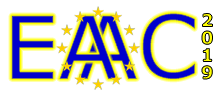Speaker
Description
In modern experiments on plasma wakefield acceleration, relativistic electron bunches (or laser pulses) excite plasma wakes with energy density comparable to the rest energy density of plasma electrons. Breaking of such wake in a radially bounded plasma is followed by its energy redistribution between hot electrons, electric fields and radial ion motion and leads to plasma column expansion via ionization of surrounding gas. This relaxation dynamics determines repetition rate of plasma accelerators. Recent E224 experiments at the SLAC FACET provided ps-time-resolved optical shadowgraphic measurements of plasma density profiles after the passage of drive electron bunch. Results demonstrate growth of the plasma column radius with a nearly constant velocity from ~100 μm to ~2 mm over 1.5 ns.
This work presents results of numerical simulations of long-term plasma column evolution in this experiment. It is shown that a fraction of electrons expelled by the bunch from plasma column propels radial ion motion. Ions at the front of expansion wave create seed plasma through ion-impact ionization. Appearance of slow electrons at given location leads to subsequent exponential plasma density growth due to electron-impact multistage ionization. Quantitative agreement with the experimental data is achieved via simultaneous consideration of all the described microscopic effects.

